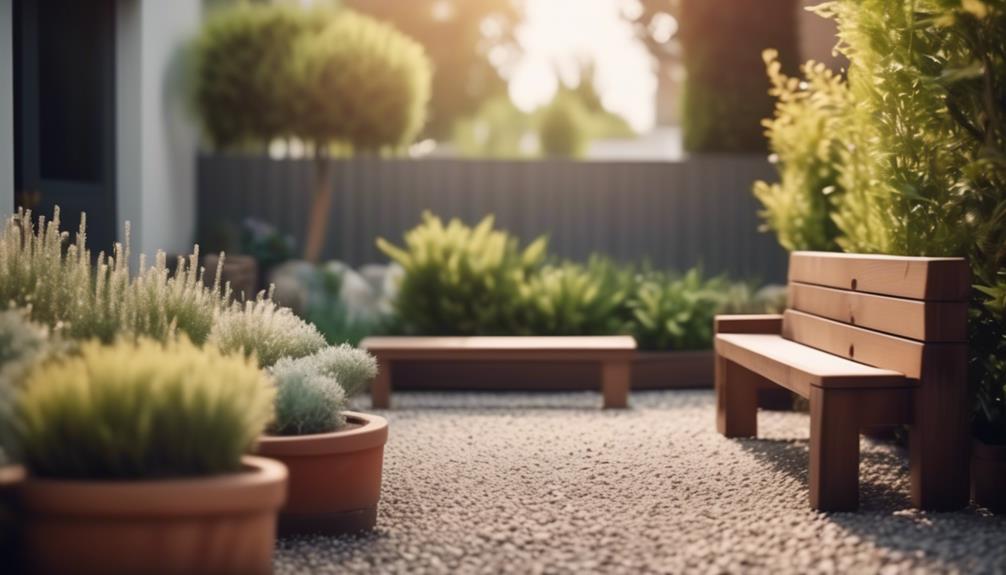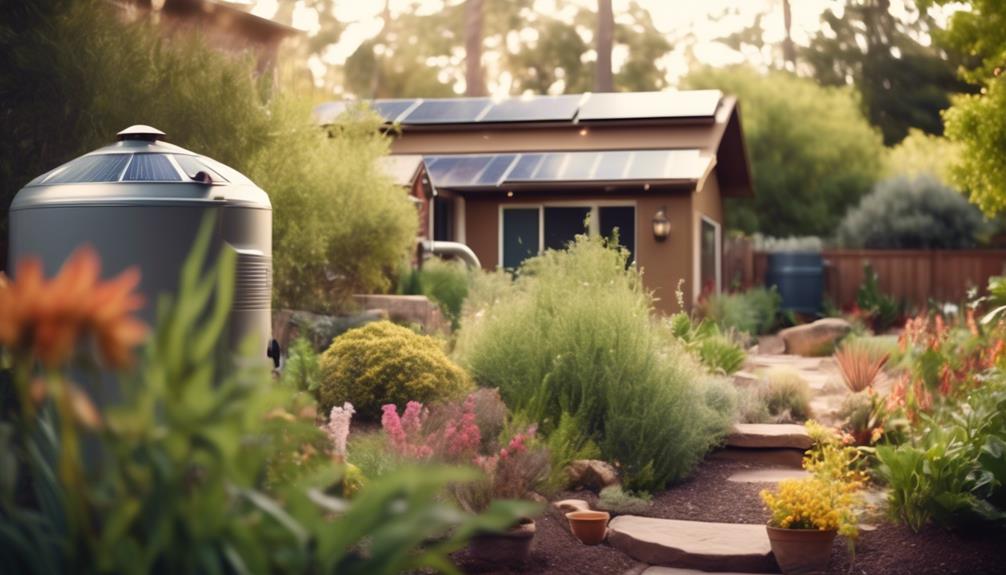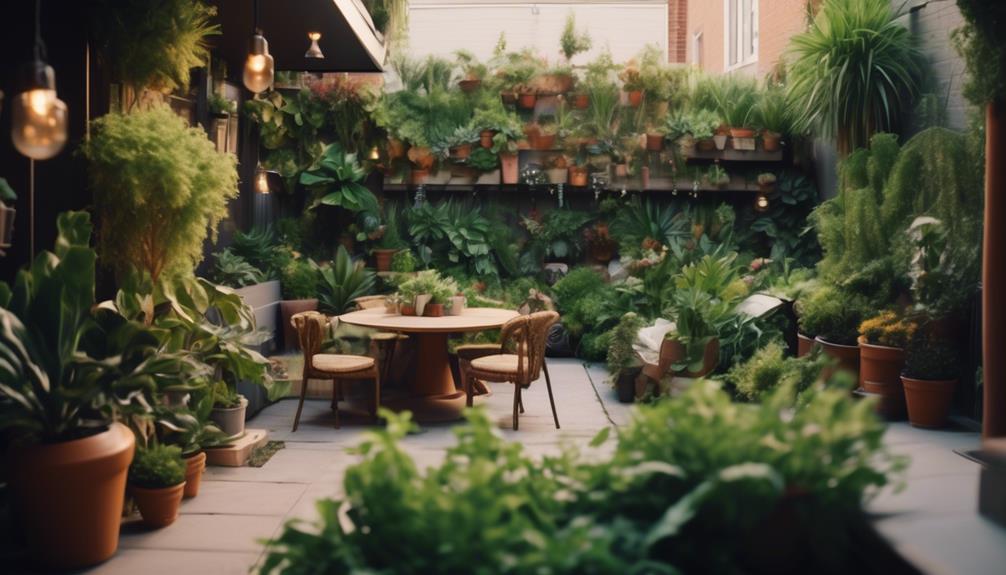As a homeowner, I often find myself seeking yard design ideas that not only enhance the aesthetic appeal of my outdoor space but also require minimal upkeep.
Picture this: vibrant greenery swaying gently in the breeze, creating a tranquil and inviting atmosphere without demanding constant attention.
How can one achieve this ideal vision of a low-maintenance yard? Well, the first step is to carefully select drought-tolerant plants that thrive with minimal water and care.
However, that’s just the beginning. There are several other practical and resourceful strategies that can be employed to create an effortlessly beautiful and easy-to-maintain yard.
Key Takeaways
- Incorporate native plants and sustainable gardening techniques to reduce watering and maintenance needs.
- Implement efficient watering techniques such as drip irrigation and rainwater harvesting to minimize water usage.
- Use organic mulch and weed control methods to retain moisture and suppress weed growth.
- Incorporate low-maintenance hardscape features like gravel paths and durable patio areas to minimize upkeep.
Drought-Tolerant Plant Selection
When selecting drought-tolerant plants for your yard, consider the specific environmental conditions and water requirements of your area to ensure optimal growth and minimal maintenance. Xeriscape landscaping, a water-saving design approach, can be achieved by incorporating native plantings and sustainable gardening techniques.
Look for native plants that are adapted to your region’s climate and soil conditions. They often require less water and maintenance once established. Consider the mature size of the plants to ensure they won’t overcrowd each other or your yard. Grouping plants with similar water needs can also help you efficiently manage irrigation.
It’s vital to pay attention to the soil composition in your yard. Amending the soil with organic matter can improve its ability to retain moisture and nutrients, reducing the need for frequent watering and fertilization.
When planning your landscape, think about maximizing water efficiency through strategic placement of plants, grouping them according to their water needs. Additionally, consider incorporating hardscapes, such as gravel pathways or mulched areas, to minimize water loss through evaporation and promote water conservation.
Efficient Irrigation Systems
To ensure efficient water use in your yard, consider implementing an irrigation system that complements the water requirements of the drought-tolerant plants you have selected. Water saving techniques and smart technology can play a crucial role in achieving this goal.
Drip irrigation is an efficient watering method that delivers water directly to the base of plants, minimizing evaporation and water waste. This system can be customized to provide the specific amount of water each plant needs, promoting eco-friendly options and reducing water usage.
Another option to consider is a rainwater harvesting system. This involves collecting rainwater from your roof and storing it in barrels or tanks. The collected water can then be used for irrigating your yard, reducing your reliance on traditional water sources and promoting efficient watering practices.
Furthermore, if you prefer a hands-off approach, smart irrigation controllers offer a convenient way to manage your watering schedule. These controllers use weather data and soil moisture levels to adjust watering times, ensuring that your plants receive just the right amount of water, without wastage.
- Creative Small Yard Landscaping Ideas for Urban Homes
- 9 Affordable DIY Yard Renovation Ideas
- Affordable DIY Landscaping Tips for Small Yards
- What Are the Best Child-Friendly Yard Designs?
- Beginner’s Seasonal Yard Maintenance Guide for London Homeowners
Strategic Mulching and Ground Cover
Considering the practical benefits of strategic mulching and ground cover, I found that using organic materials like wood chips or straw not only helps to retain moisture in the soil but also suppresses weed growth effectively. This approach not only reduces the need for frequent watering but also fosters soil health by promoting the decomposition of organic matter.
When selecting ground cover, I prioritized low-maintenance options such as drought-tolerant plants or spreading succulents, which not only minimize soil erosion but also add aesthetic appeal to the yard. Additionally, incorporating a layer of mulch helps to insulate the soil, maintaining a stable temperature for the roots of plants.
To further enhance weed control, I made sure to lay down a barrier such as landscaping fabric before applying the mulch. This extra step prevents weeds from taking root in the soil beneath the mulch.
Minimalist Hardscape Features
Incorporating minimalist hardscape features such as gravel paths and simple patio areas has helped me create a low-maintenance yard with clean lines and modern appeal. A sleek pathway made of gravel not only adds visual interest but also reduces the need for regular maintenance. It allows for proper drainage and is easy to refresh by simply raking the gravel to keep it looking tidy. Additionally, a modern patio area with clean-cut pavers or concrete slabs provides an inviting space for outdoor activities without demanding extensive upkeep.
| Minimalist Hardscape Features | Benefits | Maintenance Tips |
|---|---|---|
| Gravel Paths | – Modern appeal – Low maintenance | Regular raking |
| Simple Patio Areas | – Clean lines – Durability | Occasional power washing |
In my own yard, I’ve found that these features not only contribute to the minimalist aesthetic I aimed for but also require minimal effort to keep them looking pristine. It’s important to choose materials that are durable and suited to the local climate, ensuring that the hardscape features remain low-maintenance for years to come.
Simplified Maintenance Strategies

As I maintain my low-maintenance yard with minimalist hardscape features, I’ve discovered practical and resourceful strategies to simplify the maintenance process.
Embracing native landscaping has been a game-changer. By incorporating plants that are native to the region, I’ve significantly reduced the need for watering, fertilizing, and pest control. These plants are naturally adapted to the local climate and soil, requiring minimal intervention.
Another key strategy I’ve employed is the use of synthetic turf. This has eliminated the need for mowing, watering, and the application of harmful chemicals. Synthetic turf provides a lush, green lawn all year round without the maintenance associated with natural grass. It’s incredibly durable and can withstand heavy foot traffic and varying weather conditions.
Furthermore, I’ve implemented a proactive approach to maintenance, conducting regular inspections to address any potential issues before they escalate. This means I spend less time on reactive maintenance and more time enjoying my outdoor space.
Frequently Asked Questions
How Can I Incorporate Edible Plants Into a Low-Maintenance Yard Design?
Incorporating edible plants in a low-maintenance yard is practical and rewarding. I use raised garden beds for herbs, fruit trees, and container gardening with drip irrigation. This saves time and resources while yielding fresh produce.
Are There Any Specific Types of Grass or Turf That Require Less Water and Maintenance?
Drought resistant grass and artificial turf are great for low-maintenance yards. Xeriscaping, which is water-efficient landscaping, is also effective. I’ve found that incorporating these elements helps create a beautiful yard that’s easy to maintain.
What Are Some Creative Ways to Use Native Plants in a Low-Maintenance Yard Design?
Using drought resistant native plants in a low-maintenance yard design can create a natural looking landscape. I recommend incorporating native grasses and wildflowers to reduce water usage and maintenance while adding a touch of local beauty.
Can You Provide Tips for Incorporating Natural Habitat for Wildlife in a Low-Maintenance Yard?
Creating a wildlife-friendly yard is rewarding. I recommend setting up bird feeders and planting pollinator gardens to attract butterflies and bees. Incorporating natural landscaping and wildlife habitats adds beauty and benefits the environment.
Are There Any Innovative Technologies or Tools That Can Help With Low-Maintenance Yard Care?
Smart irrigation systems and robotic mowers are game-changers for low-maintenance yard care. They streamline watering and mowing, saving time and effort. These technologies have made a significant impact on my yard maintenance, allowing me to enjoy my outdoor space more.
Conclusion
In conclusion, creating a low-maintenance yard design doesn’t have to be complicated. By choosing drought-tolerant plants, installing efficient irrigation systems, using strategic mulching and ground cover, incorporating minimalist hardscape features, and implementing simplified maintenance strategies, you can create a beautiful and easy-to-care-for outdoor space.
With these practical and resourceful ideas, you can enjoy a low-maintenance yard that still looks great all year round.

